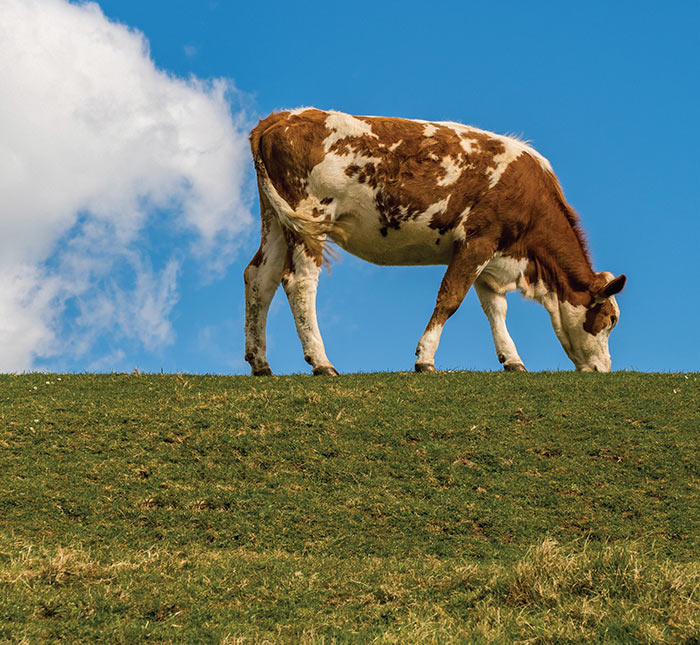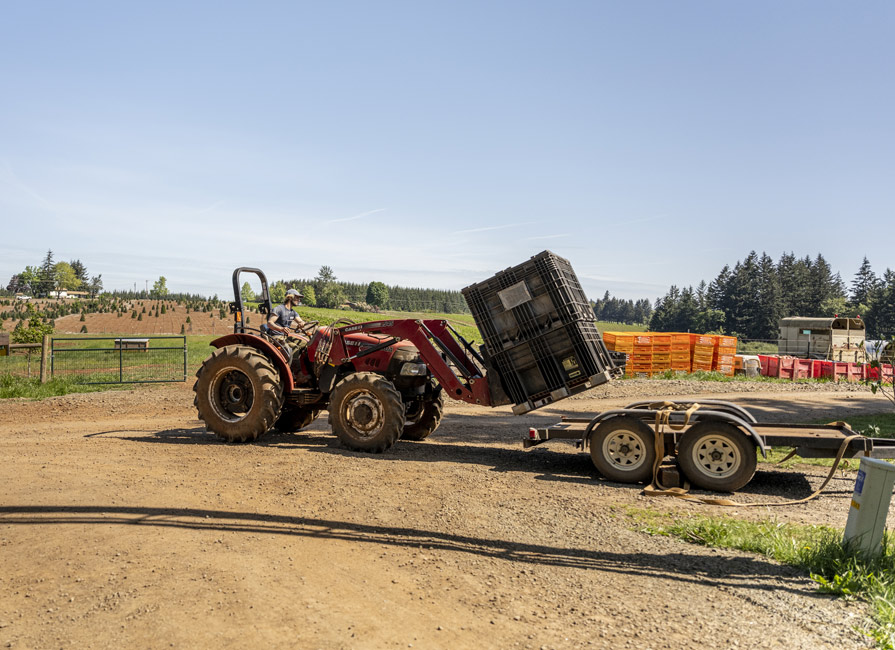One of the key attractions of our Certified Regenerative by AGW program is its practical…

A Convenient Untruth
By Simon Fairlie. This article was originally printed in the Spring 2019 (Volume 4 Issue 2) of Sustainable Farming magazine. To read the full issue please visit agreenerworld.org/resources/sustainablefarmingmagazine.
Ruminants, and particularly cattle, are habitually cast as climate villains, responsible for large amount of greenhouse gas emissions. According to a much quoted United Nations Food and Agriculture Organization (FAO) figure, livestock are responsible for 14.5 percent of human greenhouse gas emissions.1 Eighty percent of these emissions come from ruminants, half being methane, and a quarter nitrous oxide.
As a result, there are innumerable scientific papers comparing the environmental impact of dairy and beef unfavorably with pork and poultry, with vegetarian diets, with milk substitutes, with test-tube meat and so on. Virtually all of these papers and the FAO’s figure of 14.5 percent are flawed because they employ a formula for equating the climate impact of methane emissions with that of carbon dioxide—through the unit known as “CO2 equivalent”—which is highly misleading.
Nearly all the mainstream media and the public remain unaware of what is in effect a calumny against ruminant livestock farmers. Myles Allen and colleagues at the Oxford Martin School at Oxford University, UK, have published useful material designed to explain this dubious accounting to non-scientific readers.
Comparing apples and pears
Methane (CH4) and carbon dioxide (CO2) act upon the global temperature in very different ways. For the first few years after it has been released into the atmosphere, a given quantity of methane will have a much stronger global warming impact than the same amount of CO2. The standard metric for equating the two gases, Global Warming Potential (GWP100), currently estimates that over 100 years a kilo of methane has 28 times as much global warming effect as a kilo of CO2, or 34 times as much if you take into account certain feedback mechanisms. The FAO’s calculation that livestock cause 14.5 percent of all anthropogenic greenhouse gas emissions is based on the 34 figure.
However, methane degrades in the atmosphere relatively quickly—it has a half-life of about 10 years—whereas CO2 is cumulative; that is to say a single emission of CO2 will remain in the atmosphere for many hundreds of years, and a series of them will accumulate, continually increasing the amount of global warming.
The difference in behavior between the two gases can be seen in the graphs (right). If emissions of the two gases are rising, then the global warming effect also rises, but more steeply in the case of CO2. If emissions of the two gases are constant, then the warming effect of methane is relatively constant, whereas the warming effect of CO2 increases as it accumulates in the atmosphere. Finally, if emissions of both gases are falling, then the net warming effect of methane begins to drop (in other words the drop in emissions has a cooling effect), whereas the warming effect of CO2 continues to increase, albeit at a slower rate, and only becomes constant when emissions cease altogether.
This means that a single pulse of CO2 can be equated to a sustained increase in the emissions rate. A farmer who has been keeping the same number of cattle on their land for several decades will not be increasing global warming significantly because the methane will be disappearing from the atmosphere almost as fast as it is being added. The same applies to a nation, or indeed the world, if its total cattle population remains stable over a number of decades.
But a single emission of CO2, say from using a tractor to spread artificial fertilizer, will remain in the atmosphere and continue to have a warming effect more or less indefinitely. And repeated emissions of CO2 from annual use of diesel and applications of fertilizer will accumulate in the atmosphere, causing the global temperatures to increase. GWP100 fails to account for this crucial difference, resulting in perverse assessments of the relative performance of the two gases and frequent exaggeration of the role played by methane.
There are none so blind …
None of this is really news. There have been plenty of scientific papers analyzing the problem.2 Myles Allen comments:3
“Researchers have debated for decades about the adequacy of this approach … The point was made in the first major climate report produced by the Intergovernmental Panel on Climate Change (IPCC) way back in 1990. Those early discussions were loaded with caveats: Global Warming Potentials, which underpin the traditional practice of CO2 equivalence, were introduced as “a simple approach … to illustrate the difficulties inherent in the concept.
“The problem with developing a concept is that people might use it. Worse they might use it and ignore all the caveats that attended its development. This is more or less what happened with GWPs as used to create CO2 equivalence.
“The science caveats were there, and suggestions for alternatives or improvements have continued to appear in the literature. But policy makers needed something (or thought they did) and the international climate negotiations community grasped the first option that became available, although this has not been without challenges from some countries.”4
This doesn’t entirely explain why the FAO, who ostensibly exist to support farmers, should adopt a metric that is so unfavorable to ruminant husbandry. There is a suspicion that FAO economists feel comfortable with GWP100 methodology (at its higher exchange rate of 34:1) because of its bias in favor of intensive fossil-fuel dependent sectors, such as pig and poultry factory farms, and against ruminant livestock herders reliant on biomass. In their original assessment in 2006, the FAO stated that “by far the largest share of emissions come from more extensive systems where poor livestock holders often extract marginal livelihoods from dwindling resources,”—a jaundiced, inaccurate view of peasant farming.5
Allen and his colleagues note that the GWP100 methodology particularly impacts upon countries with a relatively high share of methane in their emissions portfolios, “which tend to be either middle income countries with large agricultural sectors … or less developed countries where agricultural emissions dominate because their energy sector is small.”
An alternative metric
They propose an alternative metric which they call “GWP*.” Instead of measuring a pulse emission of CO2 against a methane pulse of the same mass, GWP* compares a pulse emission of CO2 with an increase in the emission rate of methane. The methane emissions resulting from adding an extra cow to a herd for an indefinite period would be directly comparable to a one-off single emission of fossil fuel CO2.
The discrepancy between the two metrics can be large, especially if emissions are declining. Under the conventional GWP100 methodology, if a source of methane undergoes a reduction of 25 percent in methane emissions over 30 years it will over that period cause global warming equivalent to 810 tons of CO2 for every ton of methane emitted in year one. Under the more accurate GWP* methodology it results in global cooling equivalent to 462 tons of CO2.6 According to USDA data, the U.S. cattle herd declined by around 20 percent from 114 million head in 1984 to 93.6 million head in 2017, a period of 33 years.7 Assuming that methane emissions per cow are broadly the same over the whole period, this means that methane emissions from the U.S. herd currently have no net global warming impact, and are probably having a global cooling effect.
The cart before the horse
The adoption of GWP* would be a great improvement over the current employment of GWP100. It provides a much fairer assessment of the climate impacts of ruminant husbandry as compared with those of intensively farmed pigs and poultry, or vegan substitutes. Many of the scientific papers comparing the impact of meat and plant-based diets would have to be reconsidered.
However, if policy-makers and politicians were doing their job and reducing CO2 emissions in line with the pathways mapped out by the IPCC to limit global warming to a rise of 1.5 degrees above pre-industrial levels, then it is questionable whether we would need any metric at all, because substantial reductions in methane emissions would be a consequence of reductions in CO2.
The increase in methane levels in the atmosphere since 2000 is in the order of 4 percent (much less than the increase in CO2 in the atmosphere over the same time). Since a constant flow of methane over time does not cause any substantial increase in global warming, it would take a relatively modest decline in methane emissions to stabilize methane levels in the atmosphere at a level that causes no increase. IPCC estimates of what is necessary to achieve stability range between a 6.1 percent drop and a “less than 30 percent” drop in methane emissions.8 Most recently, in the pathways which it proposes to limit global warming to 1.50, the IPCC advocate a drop in methane emissions of “35 percent or more relative to 2010 levels”. Net emissions of CO2, on the other hand, because they are cumulative, have to be reduced to zero by 2050.9
The IPCC also points out that “non-CO2 emissions can be reduced as a result of broad mitigation measures in the energy sector.”10 In other words, as we progressively reduce fossil fuel use and CO2 emissions to zero, reductions in methane emissions are likely to follow:
- About one third of anthropogenic methane emissions result directly from the extraction of fossil fuels, particularly gas, which is partially composed of methane. If and when the use of fossil fuels declines to zero, we can expect the associated methane emissions to decline correspondingly.
- Another one-sixth of methane emissions come from landfill. As we transition from fossil fuels to a circular bioeconomy, and abandon throwaway plastics, landfill will become increasingly rare and associated methane emissions will also diminish.
- Another third of anthropogenic methane emissions are derived from livestock. But we can reasonably expect these to decline as well, as a result of reduced fossil fuel availability. Artificial fertilizers will become more expensive, leading to reduced animal feed production; and livestock will be competing for grazing and forage land with the demand for biomass energy.
Some methane will no doubt rebound in other forms—for example, from leaky biogas plants, compost heaps and so on. But the point here is that methane emissions are not the driver of global warming; they are better understood as a symptom or function of a system currently driven by fossil fuel extraction.
There is a danger that the increasing clamor for a reduction in livestock emissions will upstage the effort to reduce the use of fossil fuels—that would be a case of putting the cart before the horse. It doesn’t matter how many people go vegan, or how little meat we eat, it will not stop global warming. Only one thing will do that—reducing net carbon emissions from fossil fuel extraction to zero.
The caveat
Nonetheless, there are strong reasons for immediately reducing meat consumption in rich countries, since the wealthy of the world eat more than their fair share. It is vital that livestock numbers do not increase around the world because that would generate more methane in the atmosphere and cause global warming. It is also vital that wide expanses of tropical forests are not cleared to support livestock—that would increase CO2 emissions. We must stop felling forests in South America to provide soy to feed to livestock in factory farms. To ensure that these scenarios do not happen, the limited amount of meat and dairy that can be sustainably produced must be distributed more equitably. The strongest argument for reducing meat consumption in industrialized countries is one of environmental justice.
Simon Fairlie is the author of Meat: A Benign Extravagance. A version of this article first appeared in The Land magazine. To subscribe, visit thelandmagazine.org.uk.
REFERENCES
- P. Gerber et al (2013), Tackling Climate Change through Livestock, FAO.
- See references 1–9 in M. Allen et al (2018), ‘A Solution to the Misrepresentations of CO2 Equivalent Emissions of Short-Lived Climate Pollutants under Ambitious Mitigation’, Climate and Atmospheric Science (a Nature partner journal), 1, article 16.
- M. Allen, D. Frame and A.H. Macey, ‘Why Methane Should be Treated Differently Compared to Long-Lived Greenhouse Gases’, The Conversation, June 2018.
- Notably from Brazil, whose targets for mitigating climate change are expressed using a different metric, GTP100, which allocates a much lower value to methane emissions over 100 years (Federative Republic of Brazil, ‘Intended Nationally Determined Contribution Towards Achieving the Objective of the United Nations Framework Convention on Climate Change’, http://www4.unfccc.int/submissions/INDC/Published%20Documents/Brazil/1/BRAZIL%20iNDC%20 english%20FINAL.pdf).
- H. Steinfeld et al (2006), Livestock’s Long Shadow, FAO. The bias in this document against peasant farming is discussed in S Fairlie (2010), Meat: A Benign Extravagance, Permanent Publications.
- Under GWP* a drop in methane emissions of 10 percent over 30 years is equivalent to zero tonnes CO2 emissions. Under GWP100 the same rate of reduction in methane emissions is regarded as equivalent to 800 tonnes of CO2eq over the 30 years, for every tonne of methane emitted in year one. Oxford Martin, Climate Metrics for Ruminant Livestock, July 2018 (https://www.oxfordmartin. ox.ac.uk/downloads/reports/Climatemetrics-for-ruminant-livestock.pdf).
- https://usda.library.cornell. edu/concern/publications/h702q636h?locale=en#release-items.
- Christine Jardine et al (2006), ‘Methane UK’, Environmental Change Institute, www.eci.ox.ac.uk; IPCC, ‘Climate Change 2001: The Scientific Basis’, 4.2, Cambridge University Press 2001; IPCC, ‘FAQ, 10.3, If Emissions of Greenhouse Gases are Reduced, How Quickly do Their Concentrations in the Atmosphere Decrease?’, 2007 (https://www.ipcc.ch/publications_and_data/ar4/ wg1/en/faq-10-3.html).
- IPPC, ‘Global Warming of 1.50: Summary for Policy Makers’, IPCC, SRI 5, para C1.2, October 2018. Myles Allen is one of the many authors of this report.
- Ibid.


